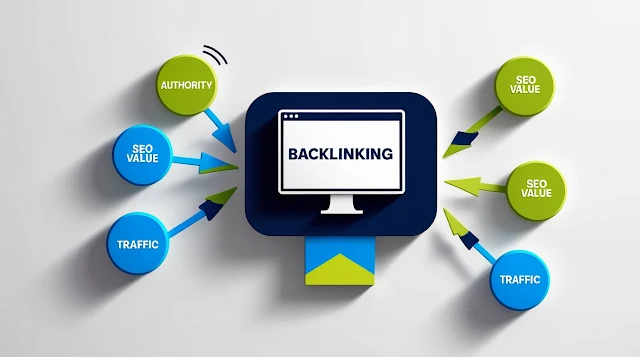Backlinking is one of the most crucial aspects of search engine optimization (SEO). It plays a vital role in improving your website’s authority, ranking, and traffic. Whether you're a beginner or an experienced marketer, understanding backlinking is essential to growing your online presence. In this comprehensive guide, we’ll explain what backlinking is, why it’s important, and how you can build high-quality backlinks to boost your SEO performance.
What Is Backlinking?
How to Get High-Quality Backlinks for Better SEO
A backlink is a link from one website to another. These links are also known as inbound links or incoming links. Backlinks act as votes of confidence from other websites, signaling to search engines like Google that your content is valuable, credible, and worth referencing.
Why Are Backlinks Important for SEO?
Backlinks are a key ranking factor in Google’s algorithm. When a website links to your content, it tells search engines that your site is trustworthy and relevant. Here’s why backlinks matter:
-
Improved Search Engine Rankings
Websites with more high-quality backlinks tend to rank higher in search engine results pages (SERPs). -
Increased Organic Traffic
Backlinks help drive referral traffic from other websites, bringing in new visitors. -
Authority Building
The more authoritative the site linking to you, the more it boosts your site’s credibility. -
Faster Indexing
Backlinks help search engine crawlers discover your site faster, which can lead to quicker indexing.
Types of Backlinks
Not all backlinks are created equal. Understanding the types of backlinks is crucial to building an effective strategy.
1. Dofollow Backlinks
These are the most valuable type of backlinks. They pass link juice (SEO value) from the referring site to your site, helping improve your rankings.
2. Nofollow Backlinks
These links include a rel="nofollow" tag in their HTML code, signaling search engines not to pass link juice. While they don’t directly impact SEO rankings, they can still drive referral traffic and improve visibility.
3. High-Authority Backlinks
Links from websites with a high Domain Authority (DA) or Domain Rating (DR) carry significant weight. Examples include links from government (.gov) or educational (.edu) websites.
4. Low-Quality Backlinks
Links from spammy or irrelevant websites can harm your SEO. Avoid these at all costs.
How to Get High-Quality Backlinks for Better SEO
Now that you understand the importance of backlinks, let’s dive into actionable strategies to earn high-quality backlinks.
1. Create High-Quality, Shareable Content
Content is the backbone of any successful backlinking strategy. Here’s how to create content that attracts backlinks:
- Write In-Depth Guides: Comprehensive articles like “The Ultimate Guide to SEO” or “Beginner’s Guide to Blogging” often earn more backlinks.
- Use Data and Statistics: Original research or data-driven content gets cited frequently.
- Infographics: Visual content is highly shareable and often linked to by other websites.
- Create Tutorials or How-To Guides: Step-by-step guides tend to attract more backlinks.
Example:
"Check out our Complete Guide to Keyword Research for actionable tips to optimize your content."
2. Guest Blogging
Guest posting on reputable websites is one of the most effective ways to build backlinks. Write valuable content for other blogs in your niche and include a link back to your site in the author bio or content.
- Find Opportunities: Use search terms like “write for us + [your niche]” or “guest post + [your topic].”
- Pitch Relevant Topics: Propose topics that align with the host site’s audience.
3. Use Broken Link Building
This technique involves finding broken links on other websites and suggesting your content as a replacement.
Steps:
- Identify broken links using tools like Ahrefs or SEMrush.
- Reach out to the site owner and offer your content as a solution.
4. Build Relationships with Influencers
Networking with influencers and bloggers in your niche can lead to natural backlinks.
- Engage on Social Media: Share their content and leave thoughtful comments.
- Collaborate on Content: Co-create content like interviews, podcasts, or guest posts.
5. Leverage HARO (Help a Reporter Out)
HARO connects journalists with sources. Sign up as a source and respond to relevant queries. If your response gets published, you’ll often receive a backlink.
6. Skyscraper Technique
The Skyscraper Technique involves improving upon existing content and reaching out to websites that link to the original.
Steps:
- Find high-performing content in your niche.
- Create a better, more detailed version.
- Reach out to sites linking to the original content and suggest your article.
7. Add Your Website to Directories
Submitting your site to relevant directories can provide easy backlinks. Focus on high-quality directories like:
- DMOZ
- Crunchbase
- Yelp
8. Write Testimonials
Many companies link back to your site if you write a testimonial for their product or service.
9. Use Social Media for Link Building
Promote your content on platforms like Twitter, LinkedIn, and Facebook to attract shares and links.
How to Identify High-Quality Backlinks
Not all backlinks are valuable. Use these criteria to assess backlink quality:
- Relevance: Links from sites in your niche are more valuable.
- Authority: Links from high-DA sites carry more weight.
- Anchor Text: The clickable text of the link should be relevant and descriptive.
- Traffic: Links from sites with high traffic can bring more visitors to your site.
Tools to Track and Build Backlinks
Several tools can help you monitor and improve your backlink profile:
- Ahrefs: Analyze backlinks and identify link-building opportunities.
- SEMrush: Track your backlink profile and compare it with competitors.
- Moz Link Explorer: Evaluate the quality of your backlinks.
- Google Search Console: Monitor which sites are linking to yours.
Common Backlinking Mistakes to Avoid
- Buying Backlinks: Paid backlinks often violate Google’s guidelines and can result in penalties.
- Focusing on Quantity Over Quality: A few high-quality backlinks are better than hundreds of low-quality ones.
- Ignoring Anchor Text: Use relevant anchor text for better SEO.
- Using Irrelevant Links: Backlinks from unrelated niches won’t help your rankings.
Conclusion
Backlinking is a powerful way to improve your website’s SEO, but it requires a thoughtful and consistent approach. Focus on creating valuable content, building relationships, and using proven strategies like guest blogging, the skyscraper technique, and broken link building to earn high-quality backlinks.
By avoiding common mistakes and leveraging tools like Ahrefs and SEMrush, you can track your progress and refine your strategy for better results.
Start implementing these tips today, and watch your site climb the search engine rankings!
For more tips, check out our SEO Resources or leave a comment below with your questions.











